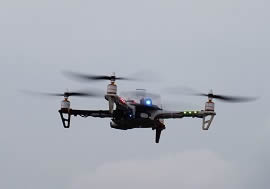| New research commissioned by the National Aeronautical Centre (NAC) reveals that 42% of logistics carriers believe their business plans to use UAVs for the distribution of cargo in future.
With fuel prices identified as one of the most important perceived risks facing the logistics industry, combined with predicted strong growth in international freight volumes, UAVs may provide cost savings for logistics companies in the long term, as it is anticipated that fuel requirements for UAVs will be lower than for conventional aircraft.
| The research also reveals over a third (36%)
of freight forwarders believe UAVs, also known as Unmanned Aerial Systems (UASs),
will be used for the future distribution of cargo.
While huge volumes of cargo are currently still transported on passenger aircraft, the
cost of this transportation method may see companies investigating alternative solutions
such as UAVs in future.
Companies surveyed across the freight and
logistics industry that believe their firm will |
 |
| use UAVs for cargo distribution are ambitious
in their timescales. On average, companies believed they would witness the introduction of
these solutions for commercial application within the next fifteen years. |
However, the NAC’s findings also reveal that those involved in the design and manufacture of UAVs will need to demonstrate to the market that in future they will truly be able to carry heavy payloads. The highest ranking concern from logistics firms and freight forwarders was that UAVs would not be able to transport sufficient tonnage to replace manned marine and air freight distribution solutions.
Ray Mann, Managing Director of West Wales Airport and architect of the NAC, said: “This research shows that there is identified, tangible demand in the marketplace for UAVs capable of facilitating the transportation of goods with significant tonnage internationally. The challenge for those involved in the design, manufacture and testing of UAVs is to leverage this demand to help secure the required resource investment to ensure the delivery of commercially viable applications.
“The NAC ensures those involved in the operation and testing of UAV solutions can utilise world-class facilities as they develop larger unmanned systems that will evolve into vehicles capable of transporting significant payloads in future.” |